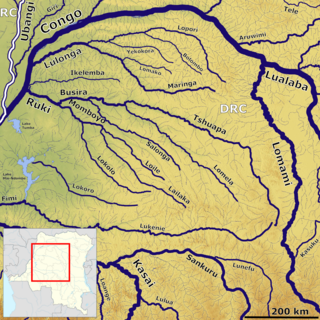Ernest Wamba dia Wamba was a prominent Congolese academic and political theorist who became a commander of the Kisangani faction of the rebel Rally for Congolese Democracy during the Second Congo War.

The Lulonga is a river in the Equateur province of Democratic Republic of the Congo. It is about 200 km long from its beginning at the town of Basankusu. The Lopori and the Maringa join to form the Lulonga there. The Lulonga River flows into the Congo River at the village of Lulonga.

Basankusu is a town in Équateur Province, Democratic Republic of the Congo. It is the main town and administrative centre of the Basankusu Territory. In 2004, it had an estimated population of 23,764. It has a gravel airstrip, covered and open markets, a hospital, and three cellphone networks, the first of which was installed in 2006. The town is also known as a centre for bonobo conservation efforts. Despite such developments, most inhabitants live at a subsistence level: hunting, fishing, keeping chickens and keeping a vegetable plot. In 2010, the workers at the local palm plantation would earn an average monthly salary of $40, most others would have much less.

The Abir Congo Company was a company that exploited natural rubber in the Congo Free State, the private property of King Leopold II of Belgium. The company was founded with British and Belgian capital and was based in Belgium. By 1898 there were no longer any British shareholders and the Anglo-Belgian India Rubber Company changed its name to the Abir Congo Company and changed its residence for tax purposes to the Free State. The company was granted a large concession in the north of the country and the rights to tax the inhabitants. This tax was taken in the form of rubber obtained from a relatively rare rubber vine. The collection system revolved around a series of trade posts along the two main rivers in the concession. Each post was commanded by a European agent and manned with armed sentries to enforce taxation and punish any rebels.
Isangi is a town in the Tshopo Province of the Democratic Republic of the Congo, headquarters of Isangi Territory.
Wamba is a village in the Luo Scientific Reserve, Tshuapa province of the Democratic Republic of the Congo. It is inhabited by Bongando people. The reserve is home to bonobos, threatened due to hunting.

The Bonobo Conservation Initiative is a non-profit organization based in Washington, D.C. and the Democratic Republic of the Congo that promotes conservation of the bonobo and its habitat in the tropical forests of the Congo Basin.
The Maringa river is a river in the Democratic Republic of the Congo. The Maringa, and the Lopori River to the north, join near Basankusu to form the Lulonga River, a tributary of the Congo River. The Maringa / Lopori basin contains the Maringa-Lopori-Wamba Landscape, an area of great ecological importance. The Ngando people live in the Maringa River area north of Ikela.
The Maringa-Lopori-Wamba Landscape (MLW) is an ecologically sensitive landscape in the Democratic Republic of the Congo within the Maringa / Lopori basin. Since 1973 a Japanese team has been researching the bonobo population near the village of Wamba, and the Luo Scientific Reserve was established in 1990. However, research was discontinued after political disorder started in 1991 followed by civil war in 1997, resuming only in the mid-2000s.
The Ngando people are Bantu subsistence farmers who live in eastern part of Équateur and the western part of Orientale province in the Democratic Republic of the Congo.
The African Wildlife Foundation (AWF) is an international conservation organization created with the aim of preserving Africa's wildlife, wild lands, and natural resources.
The Budu people (Babudu) are a Bantu people living in the Wamba Territory in the Orientale Province of the Democratic Republic of the Congo. They speak the Budu language.

The Bolombo River is a river in Équateur province, Democratic Republic of the Congo. The Bolombo is a tributary of the Lopori River. The Lopori River joins with the Maringa River to the south, to form the Lulonga River, a tributary of the Congo River. The Bolombo flows through the Lopori / Maringa basin, also known as the Maringa-Lopori-Wamba forest Landscape, an area of great ecological importance.

The Yekokora River is a river in Équateur province, Democratic Republic of the Congo. The Yekokora is a tributary of the Lopori River. The Lopori River joins with the Maringa River to the south, to form the Lulonga River, a tributary of the Congo River. The Yekokora flows through the Lopori / Maringa basin, also known as the Maringa-Lopori-Wamba forest Landscape, an area of great ecological importance.

The Lomako River is a river in Équateur province, Democratic Republic of the Congo. The Lomako is a tributary of the Maringa River. The Maringa River joins with the Lopori River to the north, to form the Lulonga River, a tributary of the Congo River. The Lomako flows through the Lopori / Maringa basin, also known as the Maringa-Lopori-Wamba Landscape, an area of great ecological importance.

Ernest Baert was a Belgian soldier, explorer and colonial administrator who was active in the Congo Free State.
The Kokolopori Bonobo Reserve is a nature reserve in the Democratic Republic of the Congo. The 4,875-square-kilometre (1,882 sq mi) reserve is a protected area for endangered bonobos and uses a community-based model of natural resource management undertaken by residents of the villages of Kokolopori and the local conservation organisation Vie Sauvage.






